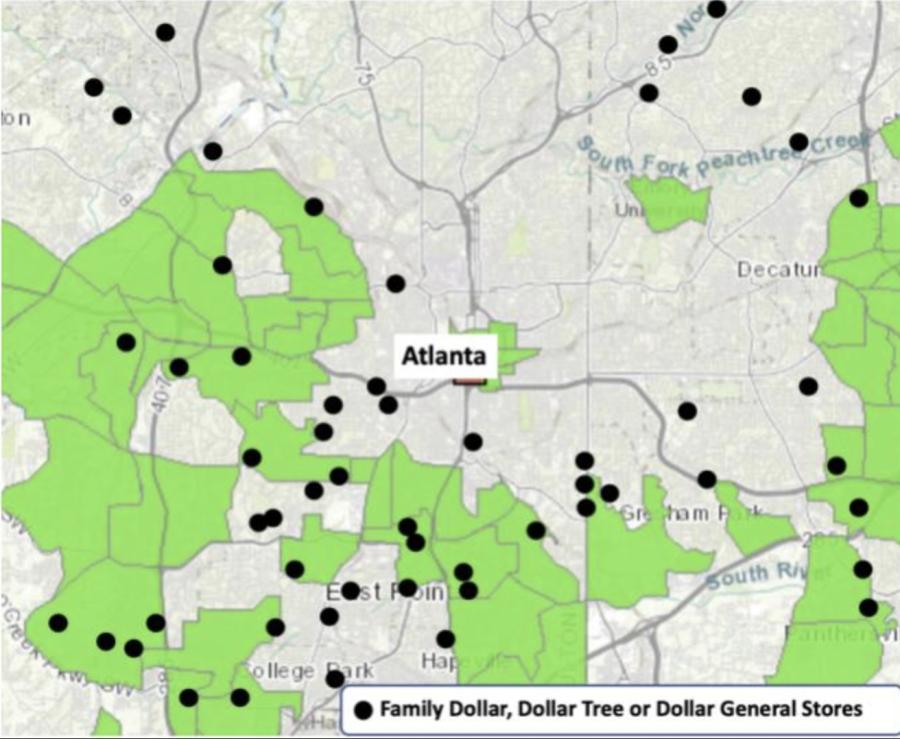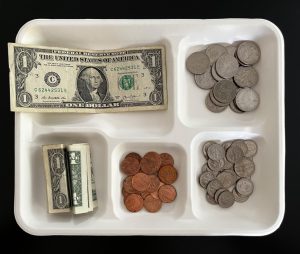Restrictions on dollar stores needed
Economic Research Service, U.S. Department of Agriculture, Food Access Research Atlas
The relationship between low-income neighborhoods and the presence of dollar stores is displayed above, with bright green representing low-income neighborhoods, and the black dots each representing one dollar store.
October 7, 2022
Over the past 20 years, the term “food deserts” has been coined by academic researchers as an area near or in a city where buying affordable or high-quality fresh food is difficult, and exist mostly in Black neighborhoods.
Many researchers blame the lack of public transportation and accessibility to grocery stores, while others argue that dollar stores are the major contributor to food deserts. With over 70 stores opened in DeKalb County alone, dollar stores congest low-income neighborhoods with cheap and over-processed food while lowering the quality of resources available.
The push for increased accessibility to fresh and affordable food was first recognized by DeKalb County officials when the commission voted unanimously to continue a moratorium on dollar stores and other discount retailers. Enacted in late 2019, the motion has been extended four times with the goal of integrating large, traditional grocery stores into low-income neighborhoods to decrease chronic health issues while improving the standard of living for residents.
The argument made by dollar store corporations surrounds accessibility: cheaper food options allow low-income members of the community to be able to afford a steady source of nutrition. Yet, these dollar stores tend to be locations of high levels of crime, worsen food insecurity by discouraging larger grocery stores from opening and disproportionately affect Black neighborhoods.
The Gun Violence Archive, a platform that records local and national news reports to track crimes involving ?rearms, lists over 200 violent incidents involving guns at Family Dollar or Dollar General stores since the start of 2017. This number has not since declined and is predicted to be the result of dollar stores being located in high-crime areas where there aren’t other businesses around to target.
High amounts of gun violence surrounding these establishments are indicators of the neglect of lower-income neighborhoods. According to ProPublica, crime is not inevitable and robberies and killings that have taken place at dollar store chains would not necessarily have happened elsewhere. The presence of dollar stores contributes to an environment where crime is typical and easier to get away with.
When a large number of dollar stores are present in an area, there is little to no incentive for grocery stores to open. Dollar stores sell cheap staples and packaged “junk-food” and rarely have fresh meat or produce. However, because of their prices, they manage to undercut grocery stores on everyday items, pushing them out of business. Since 2011, the number of dollar stores nationwide has climbed from about 20,000 to nearly 30,000 with more locations than Walmart and McDonald’s combined, with 13,000 and 5,000 respectively.
In theory, having healthier foods available would reduce chronic illnesses and support low-income neighborhoods, although Caroline George and Adie Tomer, reporters for Brookings, argue that it is an issue of demand and not the supply of healthy foods.
In a report published in the Quarterly Journal of Economics, economists chartered grocery purchases from around 10,000 households located in former food deserts, where new supermarkets have opened. Their results indicated that people didn’t buy healthier food when they started shopping at a new local supermarket.
Because the demand for cheap, low-maintenance and good-tasting food is a major factor in health and well-being, experts suggest that it is not the supply of dollar stores that needs to be adjusted, but what people pay and how they are educated about their eating habits. The Conversation, an independent news organization, stated in “Eliminating food deserts won’t help poorer Americans eat healthier,” that tweaking prices on goods could be a more effective method to encourage healthier habits.
Taxes on processed foods can discourage consumption, while food-stamp programs could be modified to make fruits and vegetables cheaper, therefore encouraging more residents to shop at grocery stores. In order to develop long-term eating habits, schools and parents can instill morals in children and encourage them to eat healthier through educational programs.
Dollar stores may be a cheap and convenient way for residents to obtain groceries and household staples at a reasonable price, but the force they hold on the health and well-being of low-income communities far outweighs the positives. With a combined effort to discourage the opening of dollar stores, such as in DeKalb County, and the increased emphasis on the enforcement of nutritional education in low-income schools, awareness of nutritional inequality will increase and the toxic environment surrounding dollar stores can be reduced.









